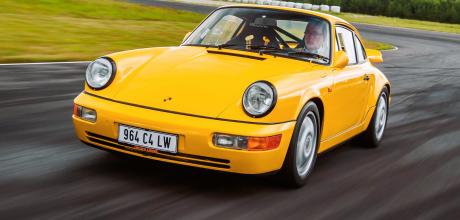1991 Porsche 911 Carrera 4 Lightweight 964
The 1991 Porsche 911 Carrera 4 Lightweight 964 is a little known motorsport footnote. Can the Leichtbau manage to trump the RS? We take to the track to find out.
911 964 C4 Lightweight
Forget the 964 RS: this is the ultimate lightweight 964! We tell the story of this competition-special classic
Written by Josh Barnett
Photography by Ali Cusick
As introductions to a new track go, this undoubtedly registers at the ‘surreal’ end of the spectrum. I’m no stranger to learning unfamiliar circuits, but I don’t normally initiate myself to new surroundings quite like this.
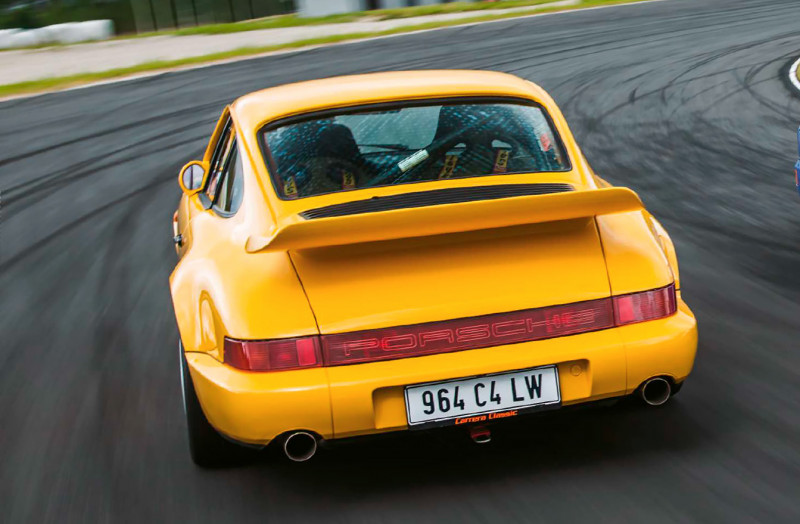
At the wheel of a 964 Carrera RS, I’m familiarising myself with Botniaring’s nine distinct turns, all the while battling 1.62 miles of damp Finnish Tarmac soaked an hour or so earlier by an unseasonably heavy rainstorm. As if that wasn’t challenging enough, I’m attempting to keep up the pace with one of Weissach’s racing legends, Jürgen Barth. Yes, that Jürgen Barth, the man who has stood on all three steps of the La Sarthe podium, topped off by a victory in the 1977 24 Hours of Le Mans.
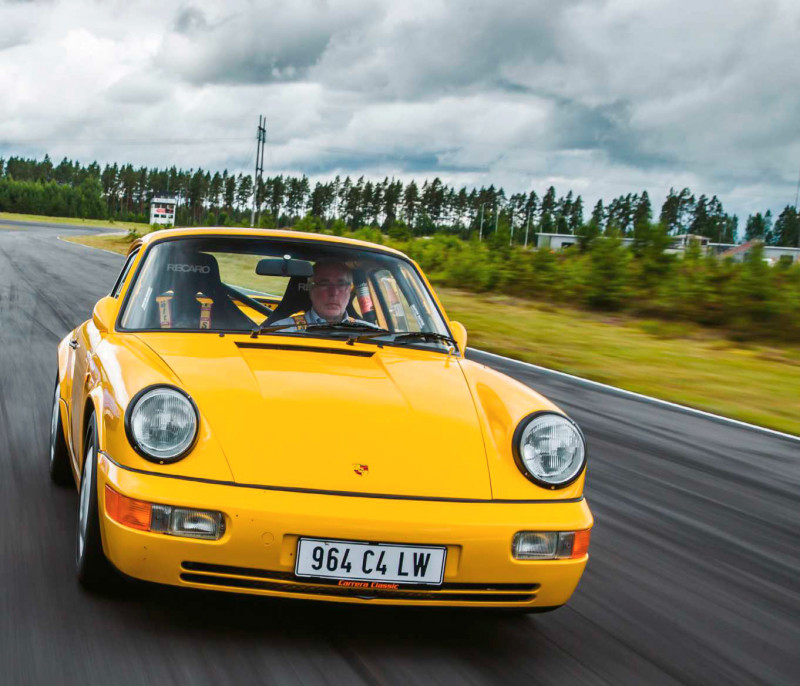
Did I mention that Jürgen is driving a near-priceless 964 Carrera 4 Lightweight, a car that he devised while heading up Porsche’s customer motorsport division? No? Well he is, and the advantage of four-wheel drive traction (and his obvious surplus of talent) is making my job entertainingly difficult. I said it was surreal. Thankfully, the 964 Carrera RS – as I found out on the Peak District’s roads in issue 128 – is the friendliest Rennsport partner a 911 enthusiast could ask for, one of the key factors behind its current resurgence in the eyes of Porsche collectors. Unlike later GT3-prefixed RSs, the 3.6-litre 964 is no high horsepower animal, meaning that I’m left to revel in the delicious chassis devised by Roland Kussmaul and co at the turn of the 1990s. More on that later though.
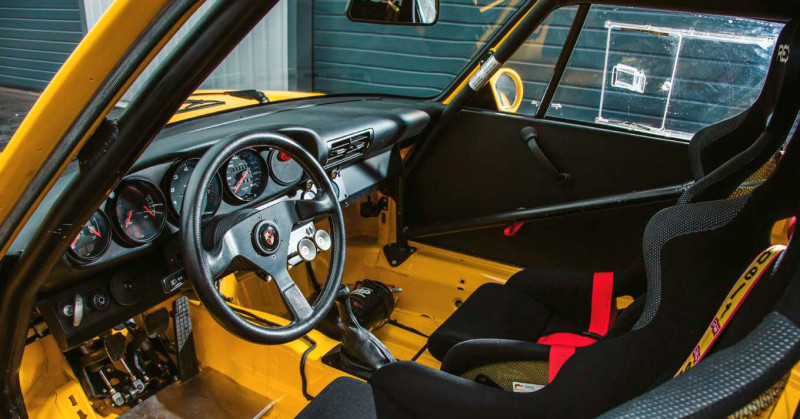
The Porsche 964 RS – the first Rennsport to get a large production run since the iconic Carrera 2.7 RS – was, like many of Weissach’s greatest road car creations, born out of the necessity to go racing. In 1988, after a six-year stint at BMW, Ulrich Bez returned to Weissach as technical director after Helmuth Bott’s decision to retire. At the time, Porsche’s Cup series in Germany and France were using the front-engined 944 Turbo but, with the 964 generation of 911 due to debut at the end of that year in 1989, Bez believed that the one-make championships were the best shop window for the new Neunelfer.
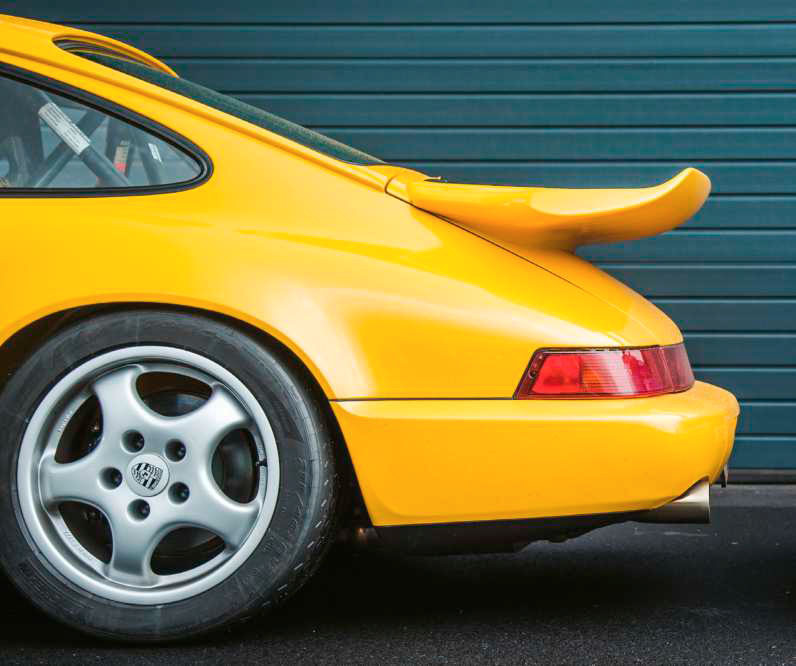
Based on the newly launched Carrera 2, research director Helmut Flegel devised the specification of the 964 Cup car before the build process was entrusted to Kussmaul, who oversaw the seam welding of the body shells and the fitment of the Matter roll cages. Contrary to popular belief, the Cup cars’ engines weren’t blueprinted. Instead, Kussmaul simply tested a selection of M64/03 engines on a dynamometer, before choosing those with the best power outputs.
With Barth in charge of the commercial side, the 964 Cup cars proved popular, debuting in 1990 with Olaf Manthey winning the inaugural Carrera Cup Germany to feature 911s. However, in order to be homologated for international competition, the FIA required a number of road cars to be built as proof of the Cup car’s production credentials. Step forward – in numerous ‘flavours’ – the 964 Carrera RS. Featuring the same seam-welded shell and 3.6-litre air-cooled flat six (boosted to 260bhp by a tweaked ECU as the Cup car), even the touring version of Rennsport inherited the Cup car’s motorsport DNA.
Compared to the standard Carrera 2, which hit the scales at a portly 1,350 kilograms, Kussmaul’s team managed to diet the Rennsport version down to a sprightlier 1,220 kilograms in Lightweight trim. An aluminium bonnet, three millimetre side and rear glass, and plastic 92-litre fuel tank all helped to reduce the RS’s dry weight, as did the pretty teardrop wing mirrors borrowed from the Turbo. Perhaps the most famous mass reduction measures though were the iconic ‘Cup 1’ alloy wheels, forged from magnesium. An instant icon, they were later offered as an option on base Carreras (albeit in a heavier aluminium alloy guise).
While a focus on weight reduction has always been a central tenet behind the Rennsport philosophy, Weissach’s engineers did not forget to upgrade a number of the 964 RS’s mechanical components either. The majority of examples were fitted with a single-mass flywheel, aiding the M64/03’s throttle response, while the standard Carrera 2’s Getrag-built ‘G50’ gearbox was bestowed with different ratios and stronger synchromeshes. A limited-slip differential was a spec sheet highlight, as were the addition of the Turbo’s cross-drilled and ventilated (ABS assisted) brake system.
The pièce de résistance though was undoubtedly the suspension setup. Benefitting from the 964’s switch to coil springs at all four corners, the RS sat a full 40 millimetres lower than the standard car, while a brace across the front axle helped to stiffen the MacPherson struts. Even at rest, the 964 Carrera RS looks right; it’s no wonder the stance has been copied by many a Carrera 2 and 4 owner.
It was also proof that, despite the lack of engine tinkering, Porsche had given the RS the attention that its famous moniker deserved. The mainstream automotive press may have been underwhelmed by its lack of headline-making power figures (the horsepower arms race continues to blind many motoring hacks) but Weissach’s attention to detail on the 964 RS truly pays off in spectacular fashion, especially on track.
Over the last 24 months, Porsche 964 Carrera RS values have shot skyward, with cars that were previously available for around £40,000 now changing hands for, in some cases, north of £200,000. The market’s reappraisal has created more than its fair share of speculators though, with the end result that many Rennsports no longer see much active service. Thankfully, the maritime blue 964 Carrera RS I’ve strapped myself into has been entrusted to me by Jussi Itavuori, a Porsche collector who appreciates that the true beauty in a 911 is not its shape or its investment potential, but the experience it creates behind the wheel.
The RS is already warm and ready to go after the morning’s trip to the track through wooded Finnish lanes, which is just as well, as Jürgen has shot out of the Botniaring’s pit lane in the 964 C4 Lightweight like the proverbially scalded cat. My pride isn’t the only thing that requires me to keep up either; our seasoned snapper Ali needs me to keep the two cars in frame for some of our planned photos. I better get a shift on…
On the road, many have complained that the 964 RS’s springing and damping is simply too stiff to enjoy. With freshly resurfaced tarmac under the Michelin Pilot Sports though, the car actually feels remarkably soft, with a suppleness to its weight transfer that immediately and, most importantly, clearly informs you of the impending changes to the Rennsport’s cornering attitude. Coupled with a power steering system that doesn’t go overly light at speed, you’ve got the perfect recipe for a hugely capable track car that anyone can get along with almost immediately.
With a single lap of the circuit under my belt, I’m already confident enough to start pushing the 964 RS’s limits. Barrelling into the 95-degree first corner, a mixture of a rapidly tightening exit parabola and a hidden damp patch at the apex conspire to give me a scare, as the kerbing on the outside of the circuit rushes up to greet me. Thankfully the car’s behaviour is constantly telegraphed to my fingertips and backside, but my complacency has taught me a key lesson. This is a 911 where managing your entry speed and angle is key. Every time I’m too aggressive with my turn in, the front end’s trajectory quickly zeroes in on the track’s edge (and the barriers beyond). Turning in too late only provokes large doses of understeer from the RS, requiring me to focus on perfecting my lines at each corner. What’s more, with stereotypically sterling traction, I can’t go all lead-footed on the accelerator in the hope of provoking some oversteer. Minimising my steering inputs and carving the ideal arc is the key to keeping up my momentum and carrying prodigious amounts of speed at each apex through the third-gear corners at turns two, three and nine.
Through the slower hairpins at turns five and six it’s easy to provoke a little bit of tail out action, especially with a judicious lift off the loud pedal. Through the ever-tightening turn four/five sequence, the business end of the RS quickly swings around. The talents of Kussmaul’s team flatter my abilities though, with a beautifully balanced relationship between anti-roll control and damping enabling me to catch the slide with relative ease. Unlike classic 911s, where the torsion bar suspension setup catches out many, the coil sprung rear end of the 964 proves much more progressive, enabling you to really get down to the business of exploiting and playing with the fantastic chassis.
Not that the handling is the only highlight to the RS’s on-track experience – 260bhp may not be much on paper but, in practice, the 964 Rennsport packs plenty of punch, especially with a welcome slug of torque from about 3,000rpm. So much so that its possibly more satisfying to shift early and enjoy another shove from the M64/03’s mid-range than ride the rev counter all the way around to its Cup car soundtracked red line.
The Botniaring’s almost constant succession of corners (linked predominantly by short straights) certainly accentuates the G50 gearbox’s long ratios. I’m only hitting fourth gear on the chute between turns one and two, with all the corners taken in either second or third gear, utilising the flat six’s torque rather than exploiting an electric top end (as you do in later GT3s). The relationship between the engine and gearbox doesn’t feel perfectly suited to the track, especially somewhere as tight and twisting as our Finnish venue.
Thankfully though, with Jürgen peeling into the pit lane, I’m about to experience a more hardcore 964 that should be better suited to the rigours of circuit work. Across the hallways at Weissach, at the same time of the 964 RS’s genesis, Barth was dreaming up his own featherweight Porsche special – not as a rival to the impending Rennsport, but as a project to keep his customer motorsport department busy. After the end of Group C’s turbocharged era, and the subsequent demise of the 956 and 962 programme, the engineers under Barth’s guidance needed something to build; something to save them from redundancy. The result was the 964 Carrera 4 Leichtbau, a delectable concoction brewed up with the assistance of Porsche Motorsport’s significant spares store.
Ever the astute businessman, Barth identified that the 964 Carrera 4 could be appropriated for competition in the US rally scene, where rules were a novelty. After convincing the board, Barth’s team set about giving the 964 its most extensive diet yet, putting even the Cup car to shame.
The bonnet was fashioned from aluminium, as were the lightweight doors, while the decklid and whaletail wing were made from fibreglass. The latter was actually a direct carry-over from the SC RS, another of Barth’s limited-run rally specials. Apart from the windscreen, all the glass was replaced with Perspex to reduce weight, with the 964’s standard Design 90 wheels forged in magnesium specially for the C4 Lightweight. Officially listed at 1,100 kilograms, the Leichtbau truly lived up to its moniker.
Inside, the interior was also completely gutted, the cockpit featuring just a pair of nomex-clad Recaro seats, a custom roll cage and a pared-back dashboard. Of the additional race-bred switchgear, two turn dials (borrowed from 935 stock) dominated. These controlled the trick differentials, the star of the C4 Lightweight show. With no rules dictating running gear, Barth decided to use up the surplus drivetrains from the 953 Dakar-winning project. The left-hand knob controlled the front-to-rear torque distribution, with the right-hand dial adjusting the level of locking on the two differentials. Mated to these trick diffs was a short ratio five-speed ‘box, while propulsion was served up by a Cup-spec 964 engine. With a motorsport exhaust manifold installed and catalytic converters removed, the Lightweight’s flat six pushed out around 265bhp (and made one hell of a racket – 107 decibels at 4,500rpm).
Mechanically, the attention to detail didn’t end there, with an adjustable front strut brace, stiffened and lowered Cup suspension (with adjustable dampers), and a dual-circuit brake system – with bias adjustment – taken, like the whaletail wing, from the SC RS. The oil tank was moved forward of the rear axle to improve weight distribution, seeing a return of the 1972-style external filler cap on the right rear wing.
This particular ‘Blume Gelb’ 964 Carrera 4 Lightweight (the only such lemon-hued Leichtbau) also belongs to Jussi and, even though it is one of just 22 ever built, I’m now replacing a Le Mans legend in its cockpit. The rapidly drying track is mine, after I’ve secured myself into the Kevlar-backed bucket seat and ensured I’m not dreaming.
Unlike the RS, which always feels like a road car from the driver’s perspective, the Lightweight’s motorsport lineage is obvious. The MOMO steering wheel is perfect to grasp, and the Spartan cockpit quickly puts my mind into focus. This car means business and that’s before I even twist the ignition. With a flick of my wrist, spark, fuel and pistons surge into life with barely hidden fury. With only a simple metal bulkhead (rather than layers of sound deadening) between my ears and the flat six, the Lightweight is noticeably more trebly and raucous, even if Jussi’s example does feature some TÜV-approved Cargraphic exhaust components.
The clutch is proper race car stuff too. It feels like 95 per cent of the pedal’s minimal travel is nothing but free play before all the engagement comes rushing in aggressively. It’s not my prettiest launch but I’m away, quickly snatching second as I approach the blend line at the end of the pit lane. Here we go.
Foot to the floor, the 6,800rpm limit rushes up so much faster than in the RS. The short ratios make the M64/01 engine feel much livelier, with my right hand almost constantly on standby for the next shift through the perfectly weighted gearbox. The lever’s throw feels a lot shorter and much more precise than the Rennsport too (though that may just be a virtue of this Leichtbau’s incredibly low mileage). The entire package feels immediately more suited to this environment. The car is certainly in its element on track, but can such an extreme chassis and drivetrain inspire the same levels of confidence in me that were achieved by the 964 RS?
I needn’t have worried. With around 130 kilograms less mass than a standard RS (Jussi’s C4 Lightweight hits the scales at 1,095 kilograms thanks to those originally optioned Kevlar seats and the Cup 1 wheels), this is a 964 that just wants to get its nose into each corner with such verve that it takes me a few turns to readjust my driving style. With less weight to shift around, the Leichtbau is more accommodating to a direct turn in and, when required at the Botniaring’s final corner complex, can change direction in a hurry. Darting left then right under my every input it’s readily apparent that, where I was driving around the idiosyncrasies of the RS’s chassis, the Lightweight accommodates my style, a sign of a thoroughbred racing weapon.
Adjusting those trick differentials is a true epiphany though. Choosing to leave the level of lock alone (I trust Jürgen’s set them pretty much correctly), the left-hand dial – the front-to-rear torque spread – enables me to alter the C4’s attitude turn-by-turn, without having to change my driving style. It’s no wonder that similar (albeit more complex) modern systems are now found on cars such as Porsche’s Le Mans-winning 919 Hybrid.
Botniaring’s fast turn three sees the track transition from heavily cambered to flat on the exit, which should normally create understeer. However, the early rain coupled with the topography has left an excitement-inducing damp patch that has been unsettling the car.
By winding the dial clockwise, I send more torque to the front wheels, countering the track conditions with greater understeer. This enables me to keep my foot hard to the floor when, in the RS, I would be lifting and losing time. Conversely, for the hairpins, I wind the torque bias all the way to the back (a total split of 80:20), forcing the Lightweight to oversteer more when I get on the throttle. It’s truly a revelation, enabling me to adjust the car’s handling on the fly, without pitting for anti-roll bar changes.
As the track dries out, I find myself winding the torque more and more to the rear while, thanks the much shorter ratios, I’m a gear up in every corner compared to the RS. It’s truly invigorating. The sound, the chassis, the drivetrain, all combining to produce an on-track experience unlike any other Porsche 911 out there. It doesn’t take me many laps to decide that I want one. Badly.
Unfortunately, prising it out of Jussi’s hands may prove difficult. Considering they are around 100 times rarer than a standard 964 RS, pricing a Leichtbau is a truly dark art (one recently sold for a rumoured €800,000). To secure the keys to this one, you might as well write down a sensible figure and then add a zero to the end of it for good measure. Compared to a Rennsport though, it would be unarguably worth it, with the RS shown up as a jack of all trades and the Leichtbau being the undoubted master.
“This is a 964 that just wants to get its nose into each corner with such verve”
Left: Kevlar-backed bucket seats hold you firmer than the RS, which is just as well given the Lightweight’s ability to stick to tarmac
Right: The Lightweight’s interior makes the RS feel plush and luxurious. Door cards are especially Spartan
TECHNICAL DATA 964 Carrera 4 Lightweight
- Years 1991-1992
Engine
- Capacity 3,600cc
- Compression ratio 11.3:1
- Maximum power 265bhp @ 6,720rpm
- Maximum torque 304Nm @ 6,720rpm
Transmission
- Five-speed manual with adjustable differential lock
Suspension
- Front MacPherson struts; Bilstein dampers; coil springs; anti-roll bar
- Rear Semi-trailing arms; Bilstein dampers; coil springs; anti-roll bar
Wheels & tyres
- Front 7x16-inch magnesium ‘Design 90’ alloys; 205/55/ZR16 tyres (17-inch Cup 1s optional)
- Rear 9x16-inch magnesium ‘Design 90’ alloys; 245/55/ZR16 tyres (17-inch Cup 1s optional)
Brakes
- Front 322mm drilled and vented discs
- Rear 299mm drilled and vented discs
Dimensions
- Length 4,275mm
- Width 1,652mm
- Weight 1,100kg
Performance
- 0-62mph 4.5 secs
- Top speed 125mph
“Ever the astute businessman, Barth saw the 964 Carrera 4 could be appropriated for competition in the US rally scene”


